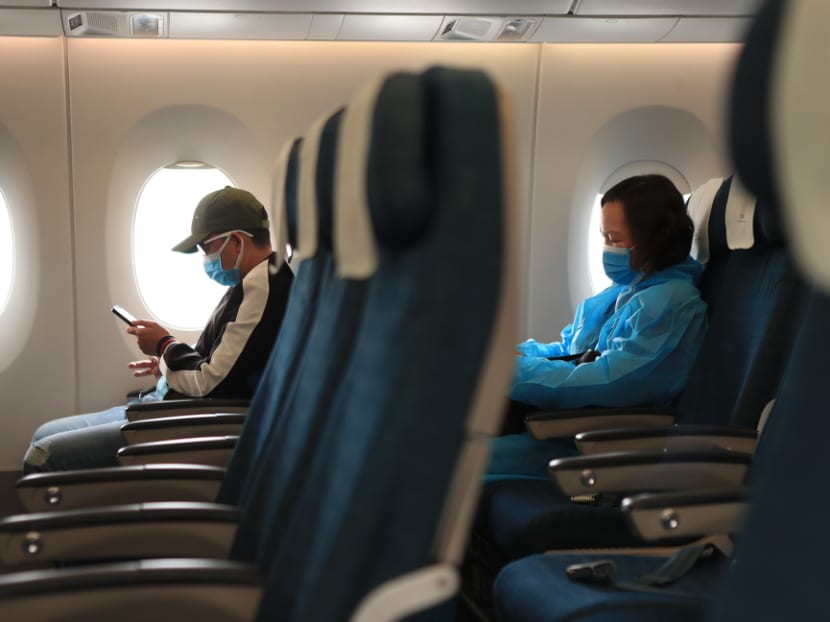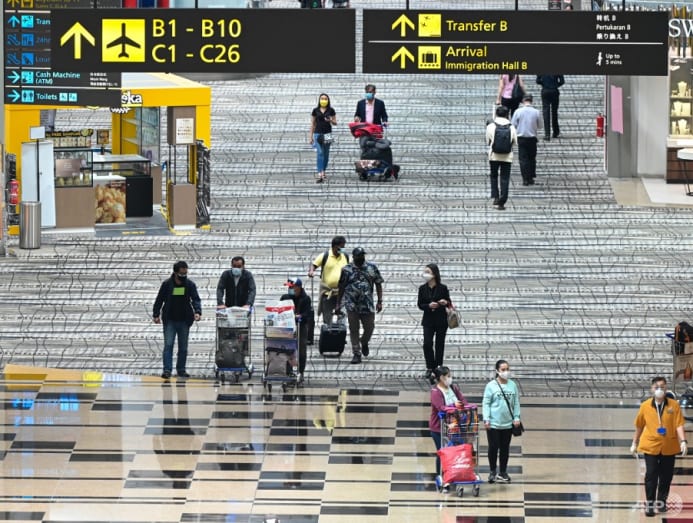Commentary: Just how risky is it to stay maskless on a plane?
Is it safe to not to wear a mask on a plane? After spending the last two years worrying about people coughing and sneezing, some hesitation is understandable, says infectious diseases specialist Asok Kurup.

SINGAPORE: Many are eager to travel now that pandemic restrictions have been lifted, but perhaps we are still hesitant about being stuck in a plane for hours without a mask. Since Aug 29, Singapore Airlines no longer requires passengers to wear masks on their flights unless travelling to or from countries which still mandate them.
Many countries have also done away with the pre-departure COVID-19 test requirement as well, or are planning to like Japan and South Korea from early September. Without the assurance that fellow passengers have tested negative, we may have one question: Just how safe is it to fly without wearing a mask?
After all, we just spent the last two years worrying about virus-laden droplets. This could be why many in Singapore have stayed masked in shopping malls even though it is no longer required.
The short answer is that it is relatively safe, if you are up to date with COVID-19 shots and boosters.
Would you be safer if you wore a mask? Yes. Would you be safer still if everyone on board all wore masks? Yes again. But the same is true of most environments.

WHAT IF SOMEONE COUGHS ON MY FLIGHT?
In some ways, planes are technically safer than many other environments. According to the International Air Transport Association (IATA), the air in passenger planes is refreshed 20 to 30 times an hour – about 10 times more often than most office buildings.
This means every two to three minutes, air in the cabin is sucked out, passed through a special high-efficiency particulate air (HEPA) filter – similar to those used in hospital operating theatres and industrial clean rooms - and then mixed with at least 50 per cent of fresh air from outside the plane, before being pumped through the cabin again.
The way the air travels around the cabin, pumped in through ceiling vents and sucked out at floor level, also helps to reduce the risk of airborne viruses spreading widely within the cabin.
PROOF OF COVID-19 TRANSMISSION ON BOARD?
Just because 10 passengers from one flight tested positive within a few days of travel does not mean they all caught the virus in the same place.
Incubation times can vary from person to person. They could have been infected days before they travelled, on the way to or from the airport, in the airport, or even after arriving at their destination.
Passengers may also be at risk when in close contact or squeezed together in the aisles during embarking and disembarking, and when the air filtration systems are switched off or working at a reduced capacity.
Numerous studies have examined flights where COVID-19 transmission on board was suspected, but there is still no conclusive answer. Without doing whole genome sequencing to identify a specific cluster, it is impossible to confirm where along their journey someone became infected.
Some studies which studied the viral genome suggested transmission was probable and most likely to occur in the same row as or in the two or three rows in front of or behind an index case. But other studies also found that no passengers seated in proximity of a symptomatic case tested positive for COVID-19.
High-traffic areas such as around the toilets and galley where people tend to gather or pass through were also potential hotspots. Other studies found that long-haul flights might be riskier than shorter journeys.
CONSIDERING PERSONAL RISK
Scientists very rarely have enough evidence to give definitive answers. More often than not, the answer lies on a spectrum – the risk of going maskless is relatively low but who you sit with and stand beside ticks the risk up.
The biggest difference today, compared to the height of the pandemic, is the availability of vaccines and the emergence of the more transmissible but less lethal Omicron variant. More travellers would have some protection through vaccination or past infection.
At the end of the day, it is a personal choice. Airlines no longer require masks but we have the choice to wear them if preferred – just as we do elsewhere in Singapore in most indoor settings. We can also wear masks at moments we know increases our risk – boarding, disembarking or when leaving our seats.
For most healthy individuals under age 60, who are up to date with vaccine shots and boosters, there is very little personal risk on a flight out of Singapore. Even if infected, most of us are unlikely to develop severe disease.
However for persons at risk of severe COVID-19 illness, it is prudent to keep the masks on.
We also have to consider others, especially if we share a home with elderly relatives or people with existing illnesses that make them more vulnerable to developing severe COVID-19 if infected.
Those who belong to a high-risk group (according to the Ministry of Health) should test and get treated for the disease early at their nearest Public Health Preparedness Clinics and polyclinics.
Dr Asok Kurup is an infectious diseases specialist at Mount Elizabeth Hospital.
BOOKMARK THIS: Our comprehensive coverage of the COVID-19 pandemic and its developments
Download our app or subscribe to our Telegram channel for the latest updates on the coronavirus pandemic: https://cna.asia/telegram












